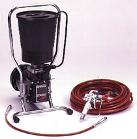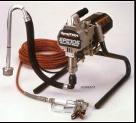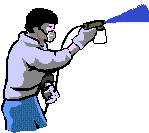WHY SPRAY PAINT? Well, two good reasons come to mind: it is the least costly of the three primary methods -- brush, roller and spray -- and it is the fastest application method.
The more irregular the space being painted, the greater the advantage of spray over other methods.
Spray painting offers maximum transfer of paint in the shortest amount of time and in a consistently uniform manner. You save money on materials because you are getting the maximum spread rate out of the paint, you are able to control the thickness of the coating applied, thin areas and "holidays" are minimized, and you are producing more square footage per hour of time spent.
For large, flat surfaces, such as plaster or wallboard, the cost is 1.2 times greater for roller and 2.2 times greater for brush application. The biggest cost differences are in labor.
Spray painting is an absolute life saver when it comes to painting some of the more difficult areas of your home. Popcorn ceilings is the first one to come to my mind and louver doors are a real close second.
When applying paint to a real difficult area like painting your attic with a Radiant Barrier Paint spraying can cut your labor spent by at least to 50% !
An airless spray rig consists of the pumping unit, hose and a gun. No compressor is needed because the paint is pumped through the high pressure hose and forced thru very small tips which break up the paint into various size spray pattern fans. The biggest advantage to airless spraying is that since no air is used to force the paint out, there is very little overspray and the air in the room is not filled with paint laden mist.
The amount of paint delivered is determined by the size of the tip used and by the amount of pressure used. Tips normally are numbered in thousands of an inch. Example: .019 tip indicates a somewhat large tip suitable for most latex paint, a .015 would be ideal for oil base paints, enamels and varnish coatings. CAUTION: The pressure at the tip is normally in the 3000 psi range and it can not only cause a severe cut but also inject paint into your skin! Keep your hands and fingers free of the tip while pressure is on the machine!
Airless spraying allows for a very uniform coat of paint and eliminates a lot of brush work and cutting in. The keys to good spraying are the proper pressure and maximum transfer of material by using good techniques.


These are typical of smaller airless spray units. One model has a hopper on top is where the paint is loaded, and the other has a simple dip tube and hose assembly which is placed down into the bucket of paint. There is a strainer on the end of the dip tube and all spray guns have at least one other strainer, normally in the handle. Some models also have a filter in behind the tip. If you are using any type of textured coating like block filler or a Ceramic Insulating Paint Be Sure and REMOVE the filters, you do not want to remove the insulating ceramic microspheres or the texture in the paint.
Tools and equipment you will need include,
 A 5 gallon bucket to mix all your paint together in, (boxing), to insure you have the same color throughout the mix.
A 5 gallon bucket to mix all your paint together in, (boxing), to insure you have the same color throughout the mix.
 Masking tape and lots of plastic to mask off areas not to be painted
Masking tape and lots of plastic to mask off areas not to be painted
 A spray mask, disposable 3M dust masks are fine for most latex paints.
A spray mask, disposable 3M dust masks are fine for most latex paints.
 A hat, long sleeve shirt, and some hand cream or lotion for your exposed skin.
A hat, long sleeve shirt, and some hand cream or lotion for your exposed skin.
Now lets get started

You Can Download the entire tutorial and save it for reference.
Requires Acrobat Reader
(Click on Logo to get it Free)
